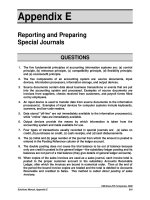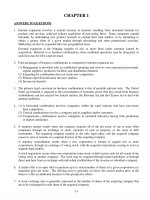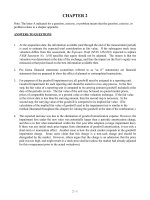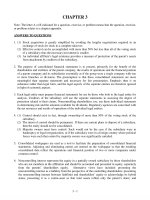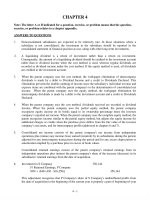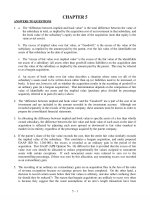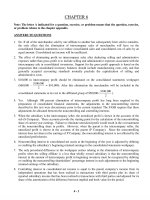Solution manual advanced accounting 4e jeter ch02
Bạn đang xem bản rút gọn của tài liệu. Xem và tải ngay bản đầy đủ của tài liệu tại đây (508.67 KB, 15 trang )
To download more slides, ebook, solutions and test bank, visit
CHAPTER 2
Note: The letter A indicated for a question, exercise, or problem means that the question, exercise, or
problem relates to a chapter appendix.
ANSWERS TO QUESTIONS
1.
At the acquisition date, the information available (and through the end of the measurement period)
is used to estimate the expected total consideration at fair value. If the subsequent stock issue
valuation differs from this assessment, the Exposure Draft (SFAS 1204-001) expected to replace
FASB Statement No. 141R specifies that equity should not be adjusted. The reason is that the
valuation was determined at the date of the exchange, and thus the impact on the firm’s equity was
measured at that point based on the best information available then.
2.
Pro forma financial statements (sometimes referred to as “as if” statements) are financial
statements that are prepared to show the effect of planned or contemplated transactions.
3.
For purposes of the goodwill impairment test, all goodwill must be assigned to a reporting unit.
Goodwill impairment for each reporting unit should be tested in a two-step process. In the first
step, the fair value of a reporting unit is compared to its carrying amount (goodwill included) at the
date of the periodic review. The fair value of the unit may be based on quoted market prices,
prices of comparable businesses, or a present value or other valuation technique. If the fair value
at the review date is less than the carrying amount, then the second step is necessary. In the
second step, the carrying value of the goodwill is compared to its implied fair value. (The
calculation of the implied fair value of goodwill used in the impairment test is similar to the
method illustrated throughout this chapter for valuing the goodwill at the date of the combination.)
4.
The expected increase was due to the elimination of goodwill amortization expense. However, the
impairment loss under the new rules was potentially larger than a periodic amortization charge,
and this is in fact what materialized within the first year after adoption (a large impairment loss).
If there was any initial stock price impact from elimination of goodwill amortization, it was only a
short-term or momentum effect. Another issue is how the stock market responds to the goodwill
impairment charge. Some users claim that this charge is a non-cash charge and should be
disregarded by the market. However, others argue that the charge is an admission that the price
paid was too high, and might result in a stock price decline (unless the market had already adjusted
for this overpayment prior to the actual writedown).
2-1
To download more slides, ebook, solutions and test bank, visit
ANSWERS TO BUSINESS ETHICS CASE
a and b. The board has responsibility to look into anything that might suggest malfeasance or
inappropriate conduct. Such incidents might suggest broader problems with integrity, honesty, and
judgment. In other words, can you trust any reports from the CEO? If the CEO is not fired, does this
send a message to other employees that ethical lapses are okay? Employees might feel that top
executives are treated differently.
ANSWERS TO EXERCISES
Exercise 2-1
Part A Receivables
Inventory
Plant and Equipment
Land
Goodwill ($2,154,000 - $1,824,000)
Liabilities
Cash
228,000
396,000
540,000
660,000
330,000
Part B Receivables
Inventory
Plant and Equipment
Land
Liabilities
Cash
Gain on Business Combination ($1,230,000 - $990,000)
228,000
396,000
540,000
660,000
594,000
1,560,000
2-2
594,000
990,000
240,000
To download more slides, ebook, solutions and test bank, visit
Exercise 2-2
Cash
Receivables
Inventories
Plant and Equipment (net) ($3,840,000 + $720,000)
Goodwill
Total Assets
$680,000
720,000
2,240,000
4,560,000
120,000
$8,320,000
Liabilities
Common Stock, $16 par ($3,440,000 + (.50 $800,000))
Other Contributed Capital ($400,000 + $800,000)
Retained Earnings
Total Equities
1,520,000
3,840,000
1,200,000
1,760,000
$8,320,000
Entries on Petrello Company’s books would be:
Cash
Receivables
Inventory
Plant and Equipment
Goodwill *
Liabilities
Common Stock (25,000 $16)
Other Contributed Capital ($48 - $16)
200,000
240,000
240,000
720,000
120,000
25,000
320,000
400,000
800,000
* ($48 25,000) – [($1,480,000 – ($800,000 – $720,000) – $320,000]
= $1,200,000 – [$1,480,000 – $80,000 – $320,000] = $1,200,000 – $1,080,000 = $120,000
2-3
To download more slides, ebook, solutions and test bank, visit
Exercise 2-3
Accounts Receivable
Inventory
Land
Buildings and Equipment
Goodwill
Allowance for Uncollectible Accounts ($231,000 - $198,000)
Current Liabilities
Bonds Payable
Premium on Bonds Payable ($495,000 - $450,000)
Preferred Stock (15,000 $100)
Common Stock (30,000 $10)
Other Contributed Capital ($25 - $10) 30,000
Cash
231,000
330,000
550,000
1,144,000
848,000
33,000
275,000
450,000
45,000
1,500,000
300,000
450,000
50,000
Cost paid ($1,500,000 + $750,000 + $50,000) =
$2,300,000
Fair value of net assets (198,000 + 330,000 + 550,000 + 1,144,000 – 275,000 – 495,000) = 1,452,000
Goodwill =
$848,000
Exercise 2-4
Cash
Receivables
Inventory
Land
Plant and Equipment
Goodwill*
Accounts Payable
Bonds Payable
Premium on Bonds Payable**
Cash
96,000
55,200
126,000
198,000
466,800
137,450
44,400
480,000
45,050
510,000
** Present value of maturity value, 12 periods @ 4%:
Present value of interest annuity, 12 periods @ 4%:
Total present value
Par value
Premium on bonds payable
0.6246 $480,000 =
9.38507 $24,000 =
*Cash paid
Less: Book value of net assets acquired ($897,600 – $44,400 – $480,000)
Excess of cash paid over book value
Increase in inventory to fair value
(15,600)
Increase in land to fair value
(28,800)
Increase in bond to fair value
45,050
Total increase in net assets to fair value
Goodwill
2-4
$299,808
225,242
525,050
480,000
$ 45,050
$510,000
(373,200)
136,800
650
$137,450
To download more slides, ebook, solutions and test bank, visit
Exercise 2-5
Current Assets
Plant and Equipment
Goodwill
Liabilities
Cash
Liability for Contingent Consideration
960,000
1,440,000
336,000
216,000
2,160,000
360,000
Exercise 2-6
The amount of the contingency is $500,000 (10,000 shares at $50 per share)
Part A
Part B
Goodwill
Paid-in-Capital for Contingent Consideration
500,000
Paid-in-Capital for Contingent Consideration
Common Stock ($10 par)
Paid-In-Capital in Excess of Par
500,000
500,000
100,000
400,000
Platz Company does not adjust the original amount recorded as equity.
Exercise 2-7
1. (c) Cost (8,000 shares @ $30)
Fair value of net assets acquired
Excess of cost over fair value (goodwill)
$240,000
228,800
$ 11,200
2. (c) Cost (8,000 shares @ $30)
Fair value of net assets acquired ($90,000 + $242,000 – $56,000)
Excess of fair value over cost (gain)
$240,000
276,000
$ 36,000
Exercise 2-8
Current Assets
Long-term Assets ($1,890,000 + $20,000) + ($98,000 + $5,000)
Goodwill *
Liabilities
Long-term Debt
Common Stock (144,000 $5)
Other Contributed Capital (144,000
$15 - $5))
* (144,000
362,000
2,013,000
395,000
$15) – [$362,000 + $2,013,000 – ($119,000 + $491,000)] = $395,000
2-5
119,000
491,000
720,000
1,440,000
To download more slides, ebook, solutions and test bank, visit
$700 ,000 $20 ,000
= 144,000
$5
$5
Fair value of stock issued (144,000 $15) = $2,160,000
Total shares issued
Exercise 2-9
Case A
Cost (Purchase Price)
Less: Fair Value of Net Assets
Goodwill
$130,000
120,000
$ 10,000
Case B
Cost (Purchase Price)
Less: Fair Value of Net Assets
Goodwill
$110,000
90,000
$ 20,000
Case C
Cost (Purchase Price)
Less: Fair Value of Net Assets
Gain
Goodwill
Case A
Case B
Case C
$10,000
20,000
0
$15,000
20,000
($ 5,000)
Assets
Current Assets
Long-Lived Assets
$20,000
30,000
20,000
$130,000
80,000
40,000
2-6
Liabilities
Retained
Earnings (Gain)
$30,000
0
20,000
0
40,000
5,000
To download more slides, ebook, solutions and test bank, visit
Exercise 2-10
Part A.
2011: Step 1: Fair value of the reporting unit
Carrying value of unit:
Carrying value of identifiable net assets
$330,000
Carrying value of goodwill ($450,000 - $375,000) 75,000
$400,000
405,000
$ 5,000
Excess of carrying value over fair value
The excess of carrying value over fair value means that step 2 is required.
Step 2: Fair value of the reporting unit
Fair value of identifiable net assets
Implied value of goodwill
Recorded value of goodwill ($450,000 - $375,000)
Impairment loss
2012: Step 1: Fair value of the reporting unit
Carrying value of unit:
Carrying value of identifiable net assets
Carrying value of goodwill ($75,000 - $15,000)
$400,000
340,000
60,000
75,000
$ 15,000
$400,000
$320,000
60,000
380,000
$ 20,000
Excess of fair value over carrying value
The excess of fair value over carrying value means that step 2 is not required.
2013: Step 1: Fair value of the reporting unit
Carrying value of unit:
Carrying value of identifiable net assets
Carrying value of goodwill ($75,000 - $15,000)
$350,000
$300,000
60,000
Excess of carrying value over fair value
360,000
$ 10,000
The excess of carrying value over fair value means that step 2 is required.
Step 2: Fair value of the reporting unit
Fair value of identifiable net assets
Implied value of goodwill
Recorded value of goodwill ($75,000 - $15,000)
Impairment loss
2-7
$350,000
325,000
25,000
60,000
$ 35,000
To download more slides, ebook, solutions and test bank, visit
Part B.
2011:
Impairment Loss—Goodwill
Goodwill
2012:
No entry
2013:
Impairment Loss—Goodwill
Goodwill
15,000
15,000
35,000
35,000
Part C.
SFAS No. 142 specifies the presentation of goodwill in the balance sheet and income statement (if
impairment occurs) as follows:
The aggregate amount of goodwill should be a separate line item in the balance
sheet.
The aggregate amount of losses from goodwill impairment should be shown as a
separate line item in the operating section of the income statement unless some of
the impairment is associated with a discontinued operation (in which case it is
shown net-of-tax in the discontinued operation section).
Part D.
In a period in which an impairment loss occurs, SFAS No. 142 mandates the following disclosures
in the notes:
(1) A description of the facts and circumstances leading to the impairment;
(2) The amount of the impairment loss and the method of determining the fair value of
the reporting unit;
(3) The nature and amounts of any adjustments made to impairment estimates from
earlier periods, if significant.
Exercise 2-11
a. Fair Value of Identifiable Net Assets
Book values $500,000 – $100,000 =
Write up of Inventory and Equipment:
($20,000 + $30,000) =
Purchase price above which goodwill would result
$400,000
50,000
$450,000
b. Equipment would not be written down, regardless of the purchase price, unless it was
reviewed and determined to be overvalued originally.
c. A gain would be shown if the purchase price was below $450,000.
d. Anything below $450,000 is technically considered a bargain.
e. Goodwill would be $50,000 at a purchase price of $500,000 or ($450,000 + $50,000).
2-8
To download more slides, ebook, solutions and test bank, visit
Exercise 2-12A
Cash
Accounts Receivable
Inventory
Land
Plant Assets
Discount on Bonds Payable
Goodwill*
Allowance for Uncollectible Accounts
Accounts Payable
Bonds Payable
Deferred Income Tax Liability
Cash
20,000
112,000
134,000
55,000
463,000
20,000
127,200
10,000
54,000
200,000
67,200
600,000
Cost of acquisition
Book value of net assets acquired ($80,000 + $132,000 + $160,000)
Difference between cost and book value
Allocated to:
Increase inventory, land, and plant assets to fair value ($52,000 + $25,000 + $71,000)
Decrease bonds payable to fair value
Establish deferred income tax liability ($168,000 40%)
Balance assigned to goodwill
$600,000
372,000
228,000
(148,000)
(20,000)
67,200
$127,200
ANSWERS TO PROBLEMS
Problem 2-1
Current Assets
Plant and Equipment
Goodwill*
Liabilities
Common Stock [(20,000 shares @ $10/share)]
Other Contributed Capital [(20,000 ($15 – $10))]
85,000
150,000
100,000
Acquisition Costs Expense
Cash
20,000
35,000
200,000
100,000
20,000
Other Contributed Capital
Cash
To record the direct acquisition costs and stock issue costs
6,000
6,000
* Goodwill = Excess of Consideration of $335,000 (stock valued at $300,000 plus debt assumed of
$35,000) over Fair Value of Identifiable Assets of $235,000 (total assets of $225,000 plus PPE fair
value adjustment of $10,000)
2-9
To download more slides, ebook, solutions and test bank, visit
Problem 2-2
Acme Company
Balance Sheet
October 1, 2011
(000)
Part A.
Assets (except goodwill) ($3,900 + $9,000 + $1,300)
Goodwill (1)
Total Assets
$14,200
1,160
$15,360
Liabilities ($2,030 + $2,200 + $260)
Common Stock (180 $20) + $2,000
Other Contributed Capital (180 ($50 – $20))
Retained Earnings
Total Liabilities and Equity
(1) Cost (180 $50)
Fair value of net assets acquired:
Fair value of assets of Baltic and Colt
Less liabilities assumed
Goodwill
$4,490
5,600
5,400
(130)
$15,360
$9,000
$10,300
2,460
2 - 10
7,840
$1,160
To download more slides, ebook, solutions and test bank, visit
Problem 2-2 (continued)
Part B.
Baltic
2012: Step1: Fair value of the reporting unit
$6,500,000
Carrying value of unit:
Carrying value of identifiable net assets
6,340,000
Carrying value of goodwill
200,000*
Total carrying value
6,540,000
*[(140,000 x $50) – ($9,000,000 – $2,200,000)]
The excess of carrying value over fair value means that step 2 is required.
Step 2: Fair value of the reporting unit
Fair value of identifiable net assets
Implied value of goodwill
Recorded value of goodwill
Impairment loss
$6,500,000
6,350,000
150,000
200,000
$ 50,000
(because $150,000 < $200,000)
Colt
2012: Step1: Fair value of the reporting unit
$1,900,000
Carrying value of unit:
Carrying value of identifiable net assets
$1,200,000
Carrying value of goodwill
960,000*
Total carrying value
2,160,000
*[(40,000 x $50) – ($1,300,000 – $260,000)]
The excess of carrying value over fair value means that step 2 is required.
Step 2: Fair value of the reporting unit
Fair value of identifiable net assets
Implied value of goodwill
Recorded value of goodwill
Impairment loss
$1,900,000
1,000,000
900,000
960,000
$ 60,000
(because $900,000 < $960,000)
Total impairment loss is $110,000.
Journal entry:
Impairment Loss
Goodwill
$110,000
$110,000
2 - 11
To download more slides, ebook, solutions and test bank, visit
Problem 2-3
Present value of maturity value, 20 periods @ 6%: 0.3118 $600,000 =
Present value of interest annuity, 20 periods @ 6%: 11.46992 $30,000 =
Total Present value
Par value
Discount on bonds payable
Cash
Accounts Receivable
Inventory
Land
Buildings
Equipment
Bond Discount ($40,000 + $68,822)
Current Liabilities
Bonds Payable ($300,000 + $600,000)
Gain on Purchase of Business
$187,080
344,098
531,178
600,000
$68,822
114,000
135,000
310,000
315,000
54,900
39,450
108,822
95,300
900,000
81,872
Computation of Excess of Net Assets Received Over Cost
Cost (Purchase Price) ($531,178 plus liabilities assumed of $95,300 and $260,000)
Less: Total fair value of assets received
Excess of fair value of net assets over cost
$886,478
$968,350
($ 81,872)
Problem 2-4
Part A January 1, 2011
Accounts Receivable
Inventory
Land
Buildings
Equipment
Goodwill*
Allowance for Uncollectible Accounts
Accounts Payable
Note Payable
Cash
Liability for Contingent Consideration
*Computation of Goodwill
Cash paid ($720,000 + $135,000)
Total fair value of net assets acquired ($1,064,000 - $263,000)
Goodwill
2 - 12
72,000
99,000
162,000
450,000
288,000
54,000
7,000
83,000
180,000
720,000
135,000
$855,000
801,000
$ 54,000
To download more slides, ebook, solutions and test bank, visit
Problem 2-4 (continued)
Part B January 2, 2013
Liability for Contingent Consideration
Cash
135,000
135,000
Part C January 2, 2013
Liability for Contingent Consideration
Income from Change in Estimate
Problem 2-5
135,000
135,000
Pepper Company
Pro Forma Balance Sheet
Giving Effect to Proposed Issue of Common Stock and Note Payable for
All of the Common Stock of Salt Company under Purchase Accounting
December 31, 2010
Cash
Receivables
Inventories
Plant Assets
Goodwill
Total Assets
Audited
Pro Forma
Balance Sheet Adjustments
Balance Sheet
$180,000
405,000
$585,000
230,000
(60,000)
287,000
117,000
231,400
134,000
365,400
1,236,500
905,000 (1)
2,141,500
_________
181,500
181,500
$1,877,900
$3,560,400
Accounts Payable
$255,900
Notes Payable, 8%
Mortgage Payable
Common Stock, $20 par
Additional Paid-in Capital
Retained Earnings
Total Liabilities and Equity
0
180,000
900,000
270,000
272,000
$1,877,900
2 - 13
(60,000)
180,000
300,000
152,500
600,000
510,000 (2)
$375,900
300,000
332,500
1,500,000
780,000
272,000
$3,560,400
To download more slides, ebook, solutions and test bank, visit
Problem 2-5 (continued)
Change in Cash
Cash from stock issue ($37 30,000)
Less: Cash paid for acquisition
Plus: Cash acquired in acquisition
Total change in cash
$1,110,000
(800,000)
95,000
$ 405,000
Goodwill:
Cost of acquisition
Net assets acquired ($340,000 + $179,500 + $184,000)
Excess cost over net assets acquired
Assigned to plant assets
Goodwill
(1) $690,000
+ $215,000
Problem 2-6
(2) ($37 - $20)
$1,100,000
703,500
$396,500
215,000
$ 181,500
30,000
Ping Company
Pro Forma Income Statement for the Year 2011
Assuming a Merger of Ping Company and Spalding Company
Sales (1)
Cost of goods sold:
Fixed Costs (2)
Variable Costs (3)
Gross Margin
$6,345,972
$824,706
2,464,095
Selling Expenses (4)
Other Expenses (5)
$785,910
319,310
Net Income
3,288,801
3,057,171
1,105,220
$1,951,951
$499 ,411
$1,951,951 – ($952,640 + $499,900) =
= $2,497,055
0
.
20
0.20
Since $2,497,055 is greater than $1,800,000 Ping should buy Spalding.
(1) $3,510,100 + $2,365,800 = $5,875,900
1.2
(2) ($1,752,360
.70) =
(3) $1,752,360
.30) + ($1,423,800
.70
$5,875 ,900 1.2
$3,510 ,100
(4) ($632,500 + $292,100)
(5) $172,600
.30
=
.85 =
.9 =
$6,345,972
$824,706
$2,464,095
$785,910
1.85 =
$319,310
2 - 14
To download more slides, ebook, solutions and test bank, visit
Problem 2-7A
Part A Receivables
Inventory
Land
Plant Assets
Patents
Deferred Tax Asset ($60,000 x 35%)
Goodwill*
Current Liabilities
Bonds Payable
Premium on Bonds Payable
Deferred Tax Liability
Common Stock (30,000 $2)
Other Contributed Capital (30,000
$26)
Cost of acquisition (30,000 $28)
Book value of net assets acquired ($120,000 + $164,000 + $267,000)
Difference between cost and book value
Allocated to:
Increase inventory, land, plant assets, and patents to fair value
Deferred income tax liability (35% $266,500)
Increase bonds payable to fair value
Deferred income tax asset (35% $60,000)
Balance assigned to goodwill
Part B Income Tax Expense (Balancing amount)
Deferred Tax Liability ($51,125 35%)*
Deferred Tax Asset ($6,000 35%)
Income Tax Payable ($468,000 35%)
* Inventory:
$100,000
10
$105,000
Patents,
8
Total
Plant Assets,
$28,000
10,000
13,125
$51,125
2 - 15
125,000
195,000
120,000
567,000
200,000
21,000
154,775
89,500
300,000
60,000
93,275
60,000
780,000
$840,000
551,000
289,000
(266,500)
93,275
60,000
(21,000)
$154,775
148,006
17,894
2,100
163,800


